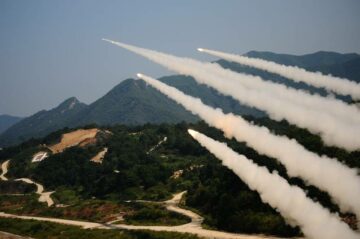
Most U.S. stocks where defense is a factor have underperformed in the S&P 500 in 2023. There have been some expectations, notably AeroVironment, Booz Allen Hamilton, and Kratos Defense and Security Solutions. In addition, most defense stocks in Europe, the Middle East and Asia have done far better than U.S. ones.
It’s too soon to say whether this pattern can or will change in 2024, but it’s worth reviewing some of the factors which will bear on U.S. defense sentiment in 2024.
Having written this while the U.S. was under a continuing resolution, the first factor will be the outcome of fiscal 2024 appropriations. The first factor will be the outcome of fiscal 2024 appropriations. There remains a wide cone of uncertainty over what Congress will get done. The most positive outcome for defense would be the enactment of FY24 appropriations at or above the administration’s request, plus the supplemental request of $106 billion.
The most negative could be a fraction of the supplemental request and continuing resolutions that last into May 2024 without changes to the Fiscal Responsibility Act of 2023. That act resets the FY24 budget to 99% of the levels appropriated in FY23 (that’s base budget only, not emergency spending).
The eventual outcome may be somewhere between the best and worst cases.
The FY24 appropriations outcome will bear on long-term sales growth expectations. Per Bloomberg, estimates of consensus sales show mid-single rates of annual growth in 2025-2026 for larger U.S. contractors, and higher rates for smaller ones. Procurement as well as research, development, test and evaluation outlays — which mostly result from FY23 and prior fiscal year appropriations — show a peak growth rate of 15% in 2024. There is not a high correlation between percentage rates of change in outlays and Defense Department-related sales, but the two move in similar directions. The outlay data is supportive of consensus sales estimates.
But beyond 2024, it may be a different story. Investment outlays show 5% growth in 2025 and 0% in 2026, with those estimates reflecting the FY24 request but not a supplemental. Stocks tend to move up when analysts increase estimates, and down when the opposite happens, which is why Congress and FY24 is so important.
There are bound to be sell-side analyst reports that trot out data showing U.S. defense stocks tend to do well in presidential election years. However, the 2024 election might be different, or at least reinforce some of the factors that have weighed on U.S. defense in 2023.
If former President Donald Trump wins the election, it could significantly alter expectations for U.S. commitments to alliances such as NATO and for support of Ukraine. Those changes could be positive for European defense in 2025 and beyond, but could entail changes to U.S. export prospects and possibly DoD top line expectations.
If President Joe Biden is reelected, there is still the possibility of split-party control of the House and Senate — and with it, the partisan entrenchment that has weighed on budgets in 2023.
Operating margins and cash flows are other factors that shape stock behavior. Arguably, operating performance has been pretty good in 2023 given the pressures industry has faced from supply networks and labor. And while there have been pockets of execution issues, these have not been sweeping. Possibly these factors remain the same in 2024, but an issue will be the health of much smaller suppliers that are highly exposed to material inflation, labor issues and higher interest rates. Prime contractors might be able to manage these issues, but surprises are still possible.
Mergers and acquisitions may be limited to movement in small and midsize companies and continued portfolio shaping at larger firms. A change in the administration’s views that would encourage more consolidation among the largest firms seems highly unlikely given concerns over loss of competition, innovation and market power.
A final factor to watch in 2024 is how the competitive landscape changes and whether smaller defense technology firms can win programs enabling them to scale. If that happens, growth expectations could be recalibrated as these private firms either go public or appreciation of their market potential is confirmed. If it doesn’t happen, and funding sources dry up for defense technology, the competitive environment might be more benign.
Byron Callan is a managing partner of the research firm Capital Alpha Partners.
- SEO Powered Content & PR Distribution. Get Amplified Today.
- PlatoData.Network Vertical Generative Ai. Empower Yourself. Access Here.
- PlatoAiStream. Web3 Intelligence. Knowledge Amplified. Access Here.
- PlatoESG. Carbon, CleanTech, Energy, Environment, Solar, Waste Management. Access Here.
- PlatoHealth. Biotech and Clinical Trials Intelligence. Access Here.
- Source: https://www.defensenews.com/outlook/2023/12/04/budgets-presidents-and-the-defense-industry-what-to-watch-in-2024/
- :has
- :is
- :not
- :where
- ][p
- $UP
- 15%
- 2023
- 2024
- 2025
- 2026
- 500
- 70
- a
- Able
- above
- acquisitions
- Act
- addition
- allen
- Alliances
- Alpha
- among
- an
- analyst
- Analysts
- and
- annual
- appreciation
- appropriations
- ARE
- arguably
- AS
- asia
- At
- base
- BE
- Bear
- been
- behavior
- BEST
- Better
- between
- Beyond
- biden
- Bloomberg
- bound
- budget
- Budgets
- but
- CAN
- capital
- cases
- Cash
- change
- Changes
- commitments
- Companies
- competition
- competitive
- Concerns
- CONFIRMED
- Congress
- Consensus
- consolidation
- continued
- continuing
- contractors
- control
- Correlation
- could
- data
- Defense
- Development
- different
- do
- DoD
- Doesn’t
- donald
- Donald Trump
- done
- down
- dry
- East
- either
- Election
- emergency
- enabling
- encourage
- Environment
- estimates
- Europe
- European
- evaluation
- eventual
- execution
- expectations
- export
- exposed
- faced
- factor
- factors
- far
- final
- Firm
- firms
- First
- Fiscal
- Flows
- For
- Former
- fraction
- from
- funding
- get
- given
- Go
- good
- Growth
- Hamilton
- happen
- happens
- Have
- Health
- High
- higher
- highly
- House
- How
- However
- HTTPS
- if
- images
- important
- in
- Increase
- industry
- inflation
- Innovation
- interest
- Interest Rates
- into
- investment
- issue
- issues
- IT
- joe
- Joe Biden
- jpg
- labor
- landscape
- larger
- largest
- Last
- least
- levels
- Limited
- Line
- long-term
- loss
- manage
- managing
- managing partner
- margins
- Market
- material
- May 2024
- May..
- Middle
- Middle East
- might
- more
- most
- mostly
- move
- movement
- much
- negative
- networks
- notably
- of
- on
- ones
- only
- operating
- opposite
- or
- Other
- out
- Outcome
- over
- partner
- partners
- Pattern
- Peak
- per
- percentage
- performance
- plato
- Plato Data Intelligence
- PlatoData
- plus
- pockets
- portfolio
- positive
- possibility
- possible
- possibly
- potential
- power
- president
- President Donald Trump
- president joe biden
- presidential
- presidential election
- Presidents
- pressures
- pretty
- Prime
- Prior
- private
- procurement
- Programs
- prospects
- public
- Rate
- Rates
- reflecting
- reinforce
- remain
- remains
- Reports
- request
- research
- Resolution
- responsibility
- result
- reviewing
- s
- S&P
- S&P 500
- sales
- same
- say
- Scale
- security
- seems
- Senate
- sentiment
- Shape
- shaping
- show
- showing
- significantly
- similar
- small
- smaller
- So
- Solutions
- some
- somewhere
- Soon
- Sources
- Spending
- Still
- stock
- Stocks
- Story
- such
- suppliers
- supply
- supportive
- surprises
- Technology
- test
- than
- that
- The
- their
- Them
- There.
- These
- this
- those
- to
- too
- top
- trump
- two
- u.s.
- Uncertainty
- under
- unlikely
- was
- Watch
- WELL
- What
- when
- whether
- which
- while
- why
- wide
- will
- win
- Wins
- with
- without
- Worst
- worth
- would
- written
- year
- years
- zephyrnet












